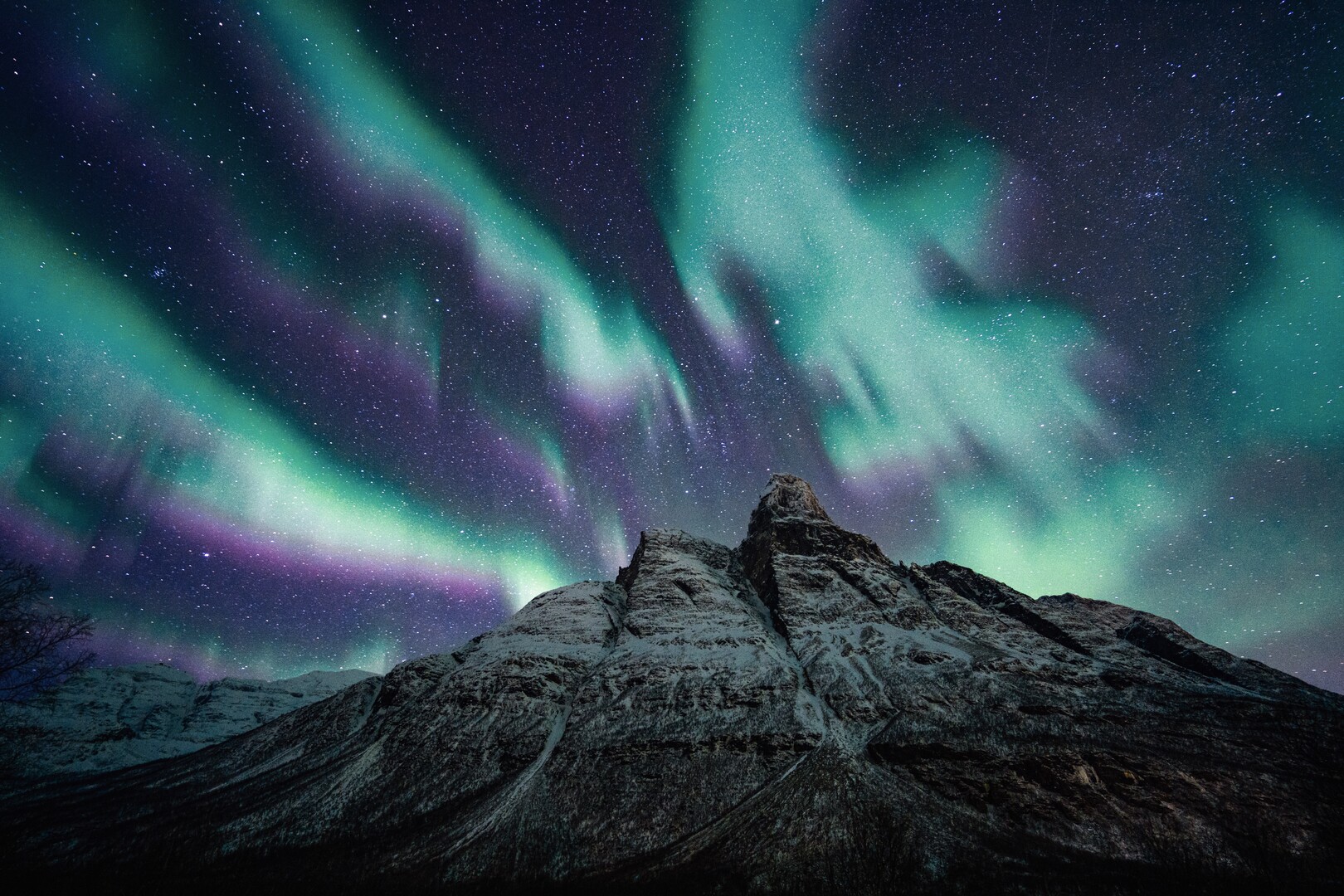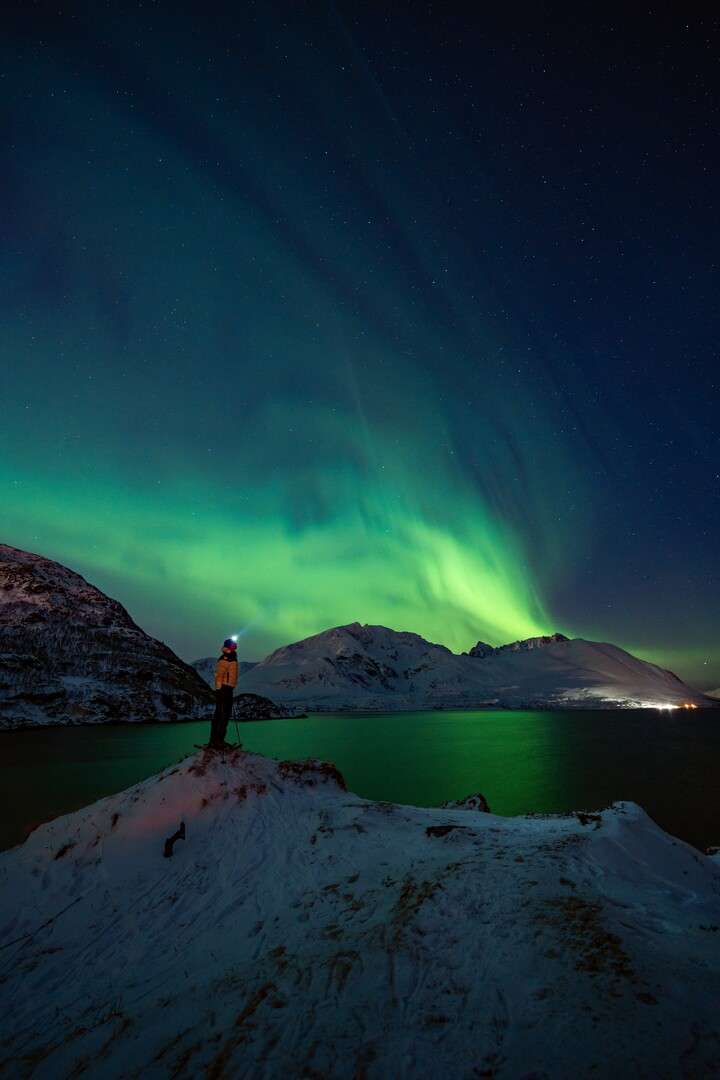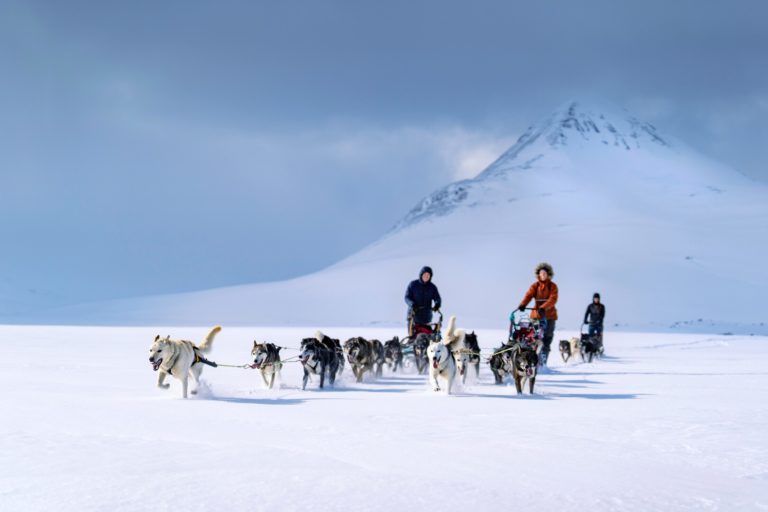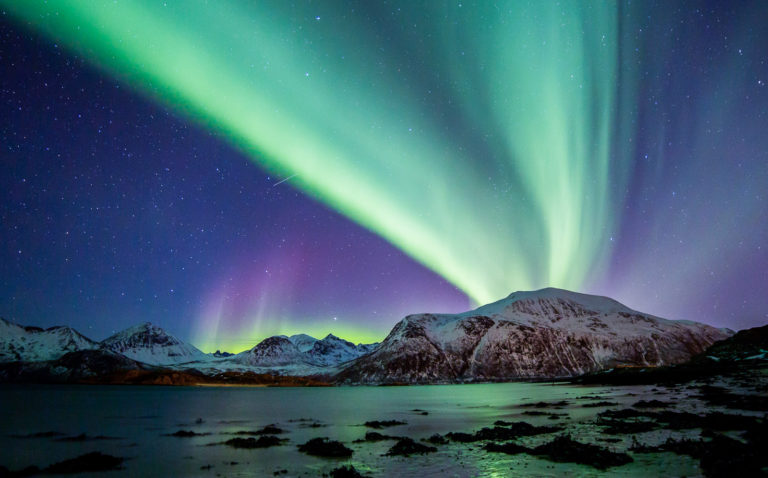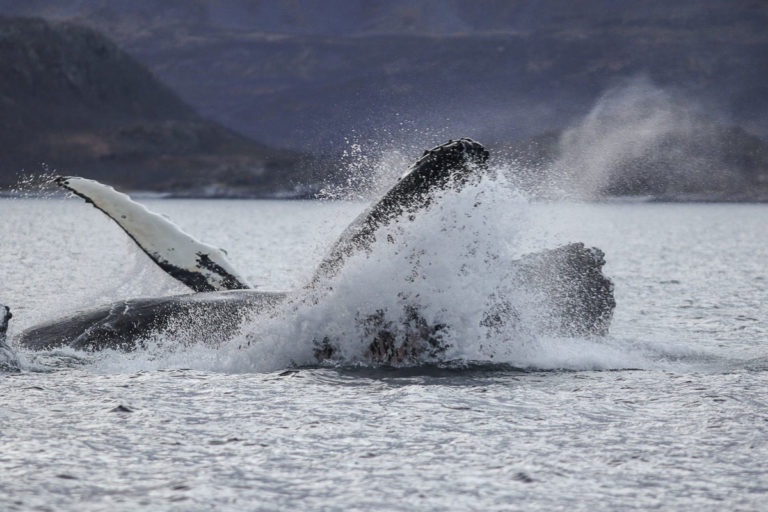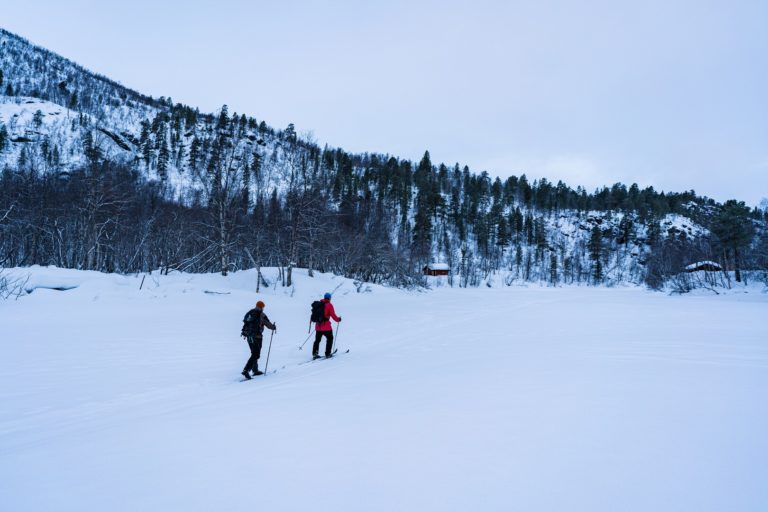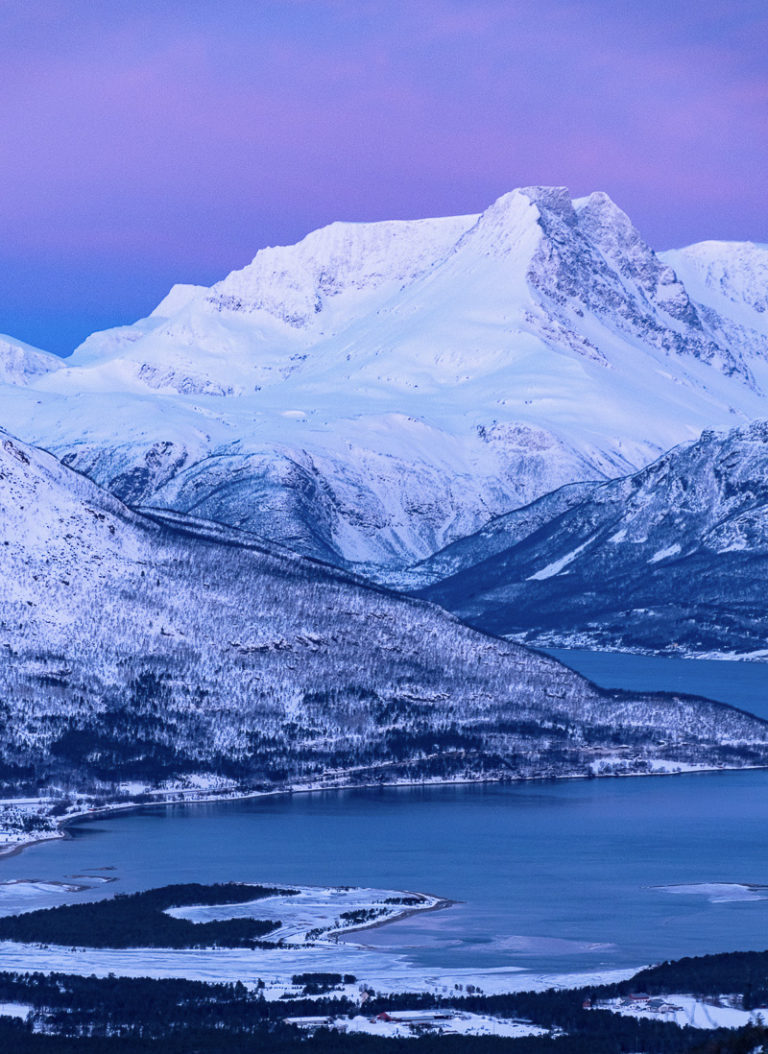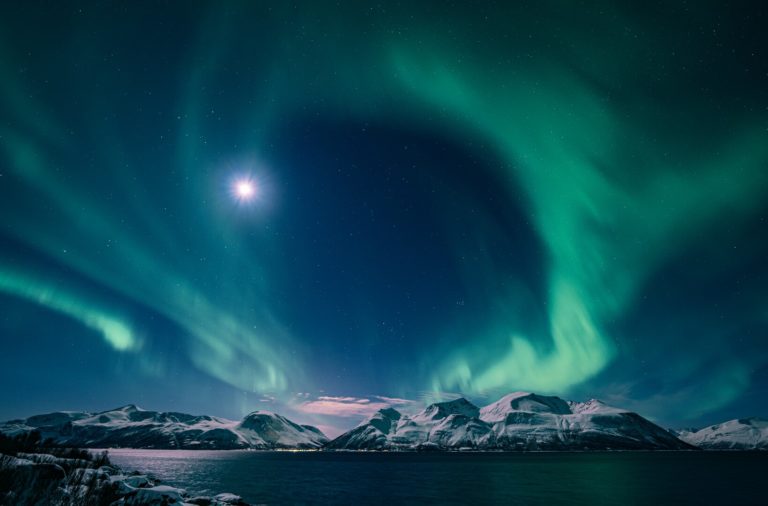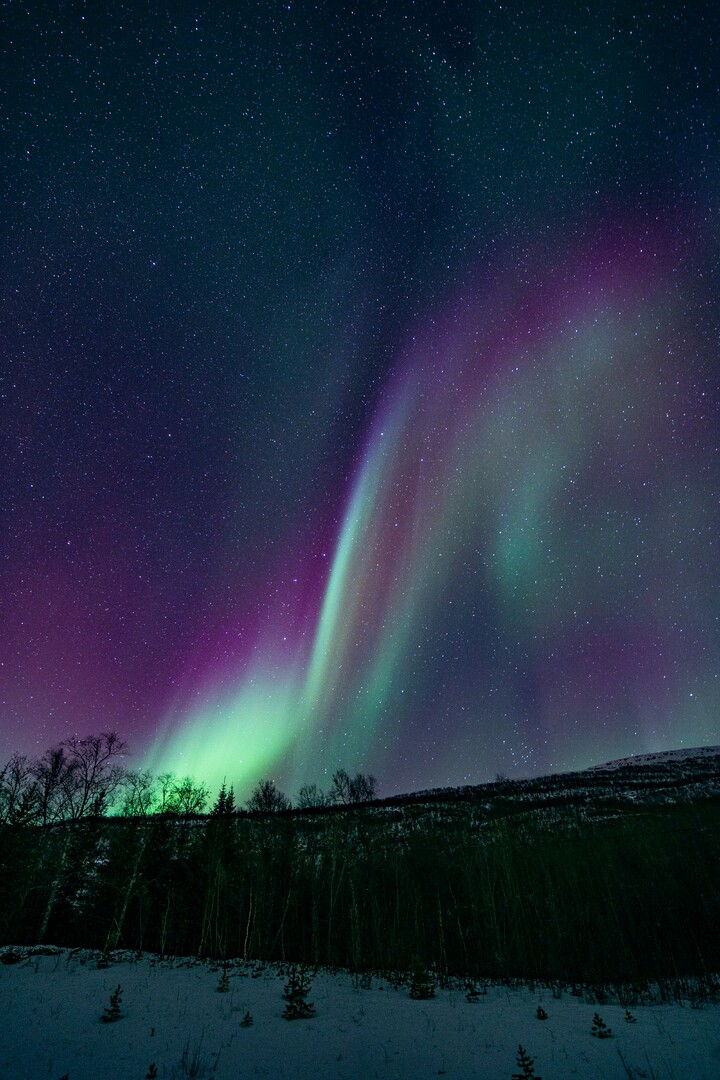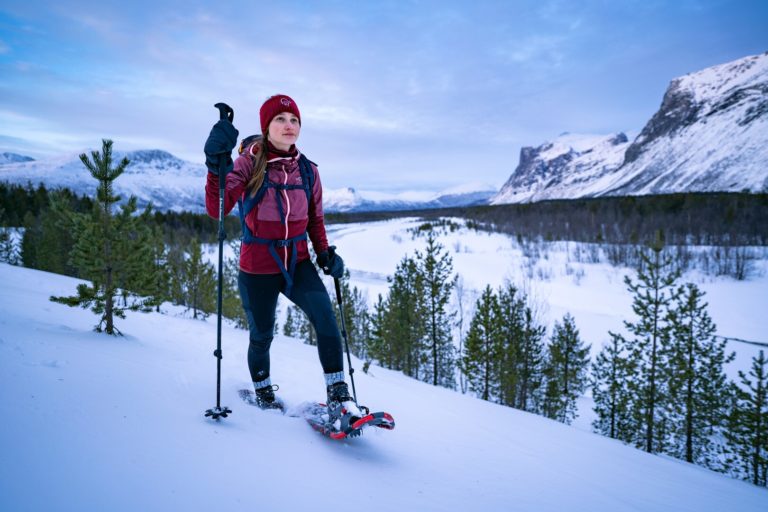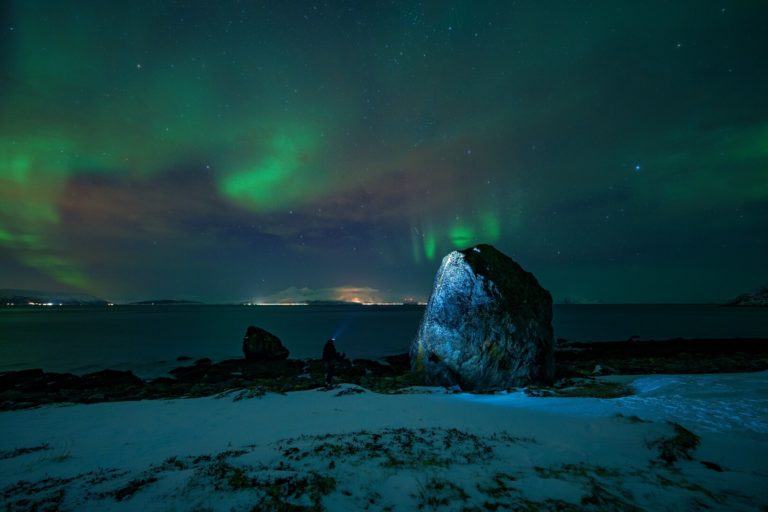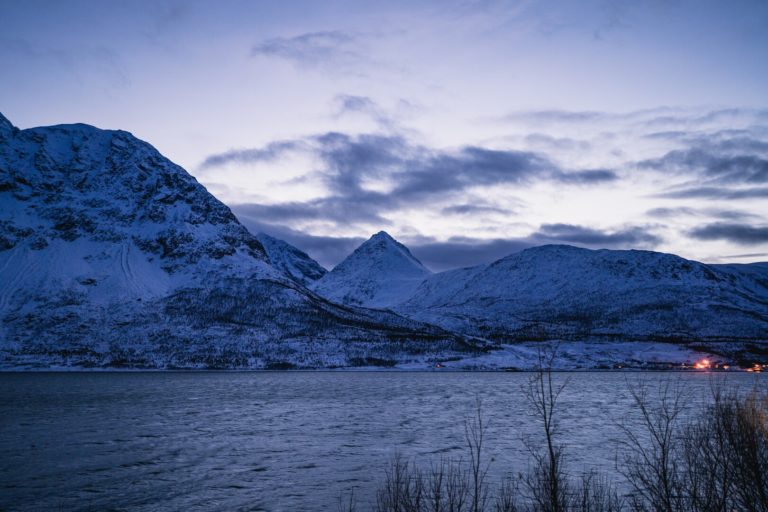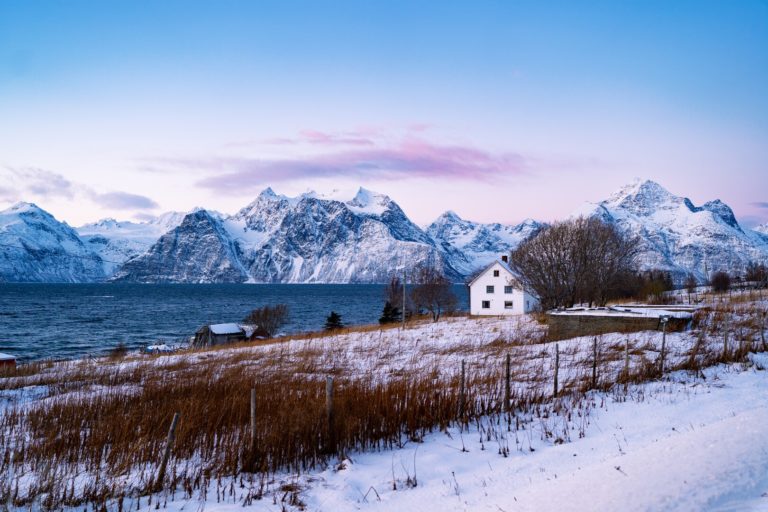Lyngenfjord is only a couple of hours away from the Arctic metropolis of Tromsø. Yet it feels like a different world, with dramatically pointed peaks, deep fjords and mountain island jutting up from the Arctic Ocean. The best, though, is the dry, stable winter climate, which is perfect for Northern Lights watching.
The Lyngen Alps are a barrier to the clouds
When the snow clouds from the Greenland ice cap or the rains following the Golf Stream come to Lyngen, they meet resistance. Up to 1833 metres high, the Lyngen Alps, Lyngsalpan, act as a barrier to the clouds. The big islands in the North, notably Arnøya and Kågen, act as a cork against the sudden Arctic lows. The Lyngenfjord area thus enjoys a stable, more continental type of weather than most of the Northern Norwegian coast. The fjord settlement of Skibotn is one of the driest spots in Northern Europe, with a mere 300 mm of annual precipitation. Similarly dry conditions are found all along the inner Lyngen Fjord and up along the Reisa river.
Less clouds means more Northern Lights
You guessed it; when there are less clouds, there are more clear, starry nights. This means you have better chances of spotting the Northern Lights. The Aurora Oval, the belt with maximum Northern Lights activity goes around the planet in a circle around the magnetic North Pole, and passes over the Lyngenfjord area every evening. But it takes clear skies to see the lights, and with Lyngenfjord’s dry, stable climate, one has increased chances compared with other destinations under the Northern Lights oval.
Sometimes the outer coast is the best
There is no rule without exception. When those cold, eastern winds blow in winter, clouds can gather around the majestic peaks along the border. This can also be the case when unseasonably warm and humid storms hit the Baltic Sea, sending mild, dry Föhn winds down our side. Then the outer coast is the place to be. From vantage points at the fjord entrance and on the big islands, one can spot the Northern Lights dance over jagged mountain or even the open sea. A key to maximising your chances is to be mobile and move from coast to inland, depending on the wind direction.
Lyngen means calm
The word Lyngenfjord itself is derived from the Old Norse word logn, meaning quiet or calm. Sheltered from the ferocious Atlantic, the shores from the Lyngen fjord and the quiet Admittedly, temperatures are usually in the double digits below, but that can easily be solved with good clothing. A solid and stable snow cover means you can be out all day and have fun in the snow.
Dog sledding is natural speeding
Loads of powdery snow and a varied landscape; the Lyngenfjord area is made for dog sledding. The huskies await you loudly and eagerly but turn quiet as they set off into the landscape. You steer it all yourself, which is learned in 2 minutes. Daytime tours are good to see the landscape, and night-time tours allow you to see the Northern Lights if they turn up.
Reindeer sledding is the most traditional transport in Lyngenfjord
Once, trade routes across Northern Scandinavia brought trade commodities to winter markets on the Lyngen Fjord, and the premier means of transport was the reindeer sleigh. Replaced long ago by modern vehicles, reindeer sledding is a fun and tranquil way of exploring the winter landscapes. Reindeer are not prone to speeding, so you get close to wildlife and scenery. A meal in a Sami lavvu is of course part of it. You can also choose to do it at night, to see the Northern Lights.
Snowmobiling takes you high up into the wilderness
Snowmobiling in the Lyngenfjord area is not about speeding, it’s about manoeuvring through a rugged, snowy winter landscape. You soon discover that you do much better than you thought. With a snowmobile, you can get deep into the wilderness and high up in the mountains for views of the stunning landscapes. Tours are also offered at night, which is a very good chance to spot the Northern Lights. Snowmobiling follows guidelines that ensure a minimum impact on wildlife.
In winter, the orcas come in for a herring buffet
Scandinavians love their herring, including the local orcas. The last few years, billions of herring have gathered and the northern end of the fjords, around the fishing village of Skjervøy, awaiting the spawning season. Where there is herring, there are also orcas. Organised tours go out to see them, and you can observe the pack of orcas sea encircling shoal of herring. One by one, according to rank, they help themselves to mouthfuls with hundreds of herring at the time. Humpbacks and finn whales also join in at the festive herring buffet. Whale safari are rules to follow, so that we can observe without disturbing. All this happens sometimes between November and the first days of February. However, this might change soon, as new generations of herring might want to wander.
The Lyngenfjord landscape is grandeur
The Lyngen Alps rise 1833 metres from the Lyngen Fjord, creating an impenetrable maze of towering peaks, deep valleys and glaciers. In winter, they are covered by snow from the sea all the way to the summit. They already impress you as you take the little ferry from Breivikeidet near Tromsø to the Lyngen Peninsula, and touring the region, you see them from different angles.
Beautiful valleys and forests hide behind the peaks
On the eastern side, small settlements under dramatic mountains line the fjord. Between the peaks, long, narrow valleys with farmland run towards the Finnish border. In Northern Norway, one should always sidetrack, and valleys like Signaldalen, Manndalen and Kåfjorddalen are well worth a detour.
The Reisa river leads to the deep forests
Another well kept secret are the deep forests around the Reisa River. Frozen pine trees, grown into bizarre shapes, line the meandering river. All is protected by rocky, jagged peaks. The landscape can be explored on skis, by snowmobile or by dog sled.
The big islands take the brunt of the storms
If you drive from the Reisa forests to the village of Årviksand, the northernmost in the area, the contrast couldn’t be bigger. Totally denuded of vegetation, exposed to the open seam houses huddled together; you’re in a different world. The small fishing town of Skjervøy is more protected, and has an air of busy urbanity, stop by the coffee shop to eat cake and listen to local gossip.
The Polar Night is a time of colour
One tends to think it’s pitch black two months around mid-winter when the sun is below the horizon. And for sure, darkness lasts for 20 hours a day, perfect to see the Northern Lights. But in those few midday hours, the sparse light plays with the white snow on the mountain peaks and the calm waters of the Lyngen Fjord, in wonderful shades of silver, gold, peach and fuchsia, until the light diminishes into a deep, transparent cobalt. Use those precious hours for sightseeing by car around the fjords, or maybe go on some fun snow activities.
February and March are sunny months
Sometimes in mid-January, you can see the sun colour the mountain tops in gold from your fjord side dwelling. Good skiers rush up the hillsides to see the eye of the sun ahead of the others. In February, days are long, the weather is stable and cold, and you have many daylight hours to sightsee and play in the snow. In March, the days are even longer, but you still get darkness in those precious night hours when the Northern Lights are at their most intense. Around April the first, the possibilities start to diminish, and three weeks into April, daylight has outdone the Northern Lights completely.
The Northern Lights can also be seen in the autumn
A totally different experience is the Autumn Northern Lights. Already late in August, you can be lucky to spot the first Northern Lights. Nights are very short, though, so the chances are slim. By mid-September, though, the lights are there in force, and you have as good chances as you have in mid-Winter. In September, you can expect frost-free nights and there is no ice you can slide on. October and November are also usually snow-free, nights although are chillier and often frosty.
The Sami were the first inhabitants around the fjords
When you let your hand stroke the coarse, yet soft, fibres of the grene rugs at Olmmaivaggi/Manndalen, you touch ancient history. Sami people have been weaving these for 1400 years, but they have probably been living much longer than that around the Lyngen Fjord. People in many of the fjord settlements are of Sami origin, and the language is alive among the older. Handicraft, costume traditions and the culinary heritage all enjoy a revival around the fjords these days.
Once, Lyngenfjord was a land of opportunities
Another deeply rooted culture of Lyngenfjord is that of the Kvens. In the 1700’s, people from Finland settled in Lyngenfjord, bringing their language, their saunas and their farming culture with them. In the Reisa valley, around Skibotn and also elsewhere, most people have Kven ethnicity, although the language is spoken only by a few. It is based on ancient Finnish dialects, with plenty of words borrowed from Norwegian and Sami.
Norwegian fishing culture
Havnnes is an old trading post, with houses dating back to the 18th and 19th c. Here, stockfish is still produced, the reason why Norwegians settled on the outer coast from the 14th c. onwards. Today, Norwegian is spoken by everyone, and mostly as a first language.
Your palate should also taste Lyngenfjord
The Lyngen Lamb is a delicacy that should not be missed. You taste all the Arctic herbs and flowers in the midnight sun with every mouthful. Prawns fished in the Lyngen Fjord are big, succulent, and tasty. Local eateries prepare them with home made sauces and mayonnaises, but if hard pressed you can buy them in a paper bag and eat them like sweets. Throw the shells to the seagulls. The sirup made of wild berries in Nordreisa is an excellent gift idea, and is perfect over ice cream. Rognballsuppe is something to look out for, a hearty meat soup with balls made out of fish roe.
The eateries are modest, but immensely popular
The restaurant scene in Lyngenfjord lacks sorely in snob factor and trend consciousness. However, ask any truck driver along the E6, and he will tell you to go to homely Bios Café in Storslett. Generous portions of local fare are their trademark, and locals make out most of the clientele. Alessandro Albertini at Solvind Restaurant, with fabulous views toward the outer Lyngen Alps, has a Mediterranean interpretation of the local raw materials. If you need a break from sightseeing, Kaffekiin in Storslett roasts its own coffee.
Cross the whisky bridge to heaven
The water of life has made it beyond the Arctic Circle. At Årøybukt, the world’s northernmost whisky distillery, Aurora Spirit Distillery, makes the “Bivrost”, an award-winning, amber whisky . Bivrost is the name of the bridge between the human world and the world of the gods in Norse mythology, often seen as inspired by the Northern Lights. Thus, a guided tour with samples fits perfectly into any Northern Lights holiday.
Lyngenfjord has no chain hotels
If you stay in Lyngen, you will invariably benefit the local community. The international chains are not here, instead you find a plethora of smaller establishments, ranging from sporty and budget friendly to luxury. And a fair bit in the mid-range category. The best overview is found at the page of Visit Lyngenfjord, where you can also book.
Hotels and hostels suit different budgets
In the major settlements, you can find smaller hotels. They have comfortable single and double rooms and serve breakfast. A restaurant is also usually to be found, maybe also a bar. A couple of places cater for the sport off-piste skiers and offer budget prices and a backpacker kind of atmosphere. Finally, there is the hostel in Northern Norway’s biggest wooden building, Solhov, once a boarding school.
Enjoy a bit of luxury on the fjord
If you have made it as far as the Lyngenfjord, you might consider splurging a little bit. Luxurious lodges line the fjords, providing spa facilities, exclusive excursions, first class cuisine and transport from Tromsø. A hassle-free arrangement, personalised service and plenty of calm are guaranteed.
Stay in a holiday home with your gang
If you travel with the whole family, or with a little group of friends, there is a number of small holiday villages throughout the area, some calling themselves “camping”, others catering for deep sea fishermen in summer. A well-equipped kitchen with a sofa nook for self-catering, private facilities and several bedrooms make them both comfortable, sociable, and reasonably priced for a group.
Rent a house from the locals
One of the more charming alternatives is to rent a holiday house. This can be a modern house, or an older house where people don’t live anymore. Study the photos closely. This ensures a homely atmosphere and character by the buckets, and you live right in the middle of the community.
You usually fly to Tromsø
Tromsø’s airport is the best connected in the entire north and has many domestic and international direct flights. Alta is north-east of the Lyngenfjord area, and has direct flights to Oslo. One could fly into Tromsø and out of Alta, or vice versa. There is even a small airstrip at Sørkjosen (SOJ), and you can get a ticket including a transfer in Tromsø. You can also get to both Tromsø and Skjervøy in the outer Lyngenfjord area with the legendary Hurtigruten ship. There is no train, the nearest railhead is in Narvik, from where there are buses to the villages around the E6, notably Skibotn, as well as Tromsø.
A rental car gives you maximum freedom
Picking up a rental car at the airport is the easiest solution, allowing you full freedom to travel. It is a good idea to have tried driving in wintry conditions before, but the tyres are studded, and the roads usually well cleared and sanded. Make sure to inform yourself on weather conditions before setting off. Do not expect there to be a car available on short notice, rental cars should be booked well ahead.
Public transport to Lyngenfjord is easier than you think
There are two daily bus connections from Tromsø to the Lyngenfjord area, along the E8, E6 and Rv 91 route to notably Lyngseidet, Skibotn, Olderdalen, Skjervøy and Storslett. The bus is relatively moderately priced, is higly reliable and on time. You can pay by using the Troms Billett app on your phone. Read more about this bus on Visit Lyngenfjord’s website. The Arctic Route, a private company catering for visitors, has bus connections to Tromsø, Alta and Finland from the Lyngenfjord area in the winter season. These connections are smart if you want to visit other regions in Northern Scandinavia as well.
Aurora makes a grand entrance
The outer areas are served by boat
Equally easy is the catamaran running from Tromsø to Skjervøy, stopping at Nord-Lenangen and Arnøyhamn on the way. Read more about island hopping on Visit Lyngenfjord’s website. You can also consider the legendary Hurtigruten between Tromsø and Skjervøy. The flight with Widerøe from Tromsø to Sørkjosen is a giant time saver, you’re less than half an hour in the air.
Combine with Tromsø
The nearby city of Tromsø seems to be the hub of activity in the winter. The city offers many attractions, a great number of organised tours, sophisticated restaurants, and a cool vibe. However, when those snow clouds empty themselves over Tromsø and the Northern Lights sulkily stay away, where do the Northern Lights chasers go? To the clear skies of Lyngenfjord! If you have a week in winter, you could spend the week-end days in merry Tromsø, then spend the weekdays in snowy, dry, beautiful Lyngen.
Organise it all yourself, or have Visit Lyngenfjord do it
An easy way of doing things is to book a hotel in Tromsø, accommodation in Lyngen through the website of Visit Lyngenfjord and a rental car, all online. Then you can book tours on Visit Lyngenfjord’s website as you go. A Northern Lights package deal from Visit Lyngenfjord includes transport from Tromsø, accommodation and a good selection of tours, all at a relatively good price. We suggest you have a look at their page.
Lyngenfjord in short
Lyngenfjord is an area roughly between Tromsø and Alta, found along the big fjord Lyngenfjord and adjacent areas. 5 municipalities are found in Lyngenfjord, Lyngen, Storfjord, Kåfjord, Nordreisa and Skjervøy.
Storslett in Nordreisa and Skjervøy are the two biggest towns, each with 2-3000 inhabitants. Larger villages include Olderdalen, Skibotn, Hatteng and Lyngseidet.
There are buses from Tromsø through Lyngseidet and Olderdalen to Storslett and Skjervøy. Other buses run from Tromsø to Nordkjosbotn, Oteren, Hatteng, Skibotn and Manndalen. There is a catamaran from Tromsø to Skjervøy, stopping at Nordlenangen on the way.
Lyngenfjord has no big hotels, but plenty of small establishments; small hotels, guesthouses, lodges, campsites with comfy huts, budget hostels and holiday homes. Make sure to check out Visit Lyngenfjord’s home page.
The Lyngenfjord area enjoys a sheltered position between the mountains, away from snow, rain and storms along the coast. This means that there are more clear skies here than elsewhere in the north. Clear skies increase your chance of spotting the lights.
Visit Lyngenfjord is the local travel organisation, providing travel information and marketing tour packages and single tours and experiences.
